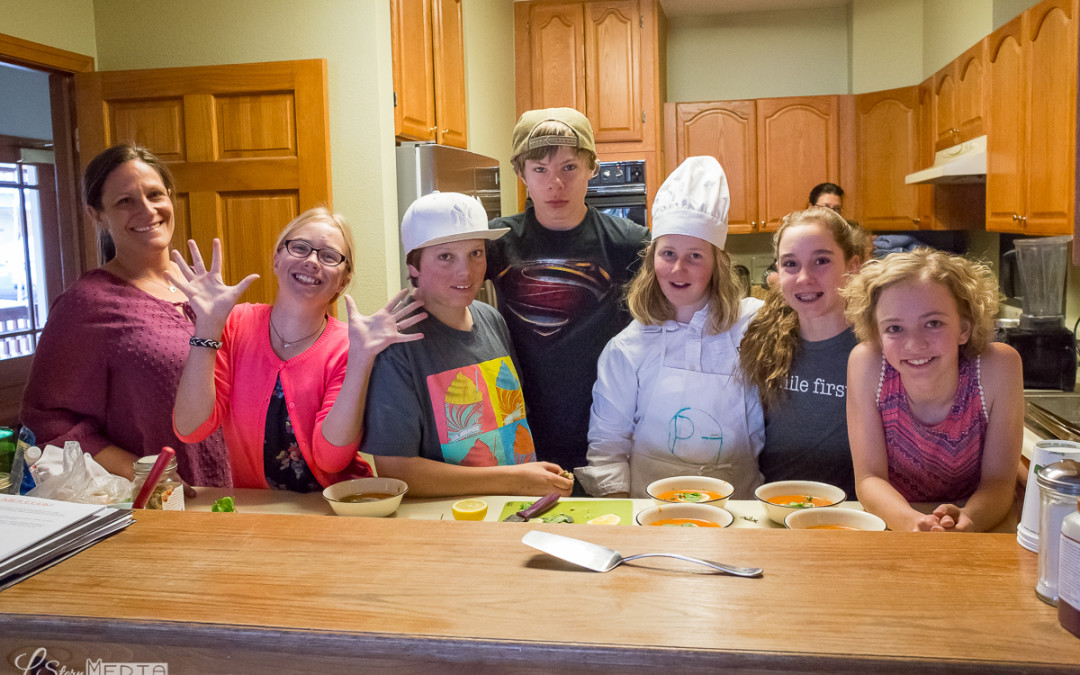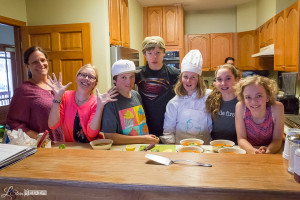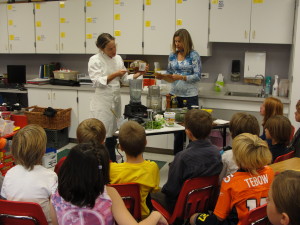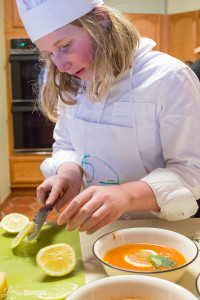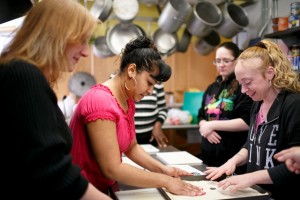At School And At Home, Scratch Cooking Is Making A Comeback
A cool, fall morning mist hovers over the ground, but a few intrepid students will make their way to the garden to harvest the last of the season’s fresh lettuce, spinach, kale, and arugula. The salad greens head straight to the school cafeteria, where they’ll be part of the school lunch on Farm to School Local Foods Day, September 30th.
This year, Local Foods Day is also “Bring a Parent to Lunch Day,” when more than 1,000 kids and their parents will have the chance to enjoy a school lunch where every item on the tray is either locally sourced, organic, fresh, or made from scratch. Colorado grass-fed beef is the main course, along with fresh local carrots, a spinach-and-mixed-greens salad, and a slice of juicy watermelon. “I think it’s wonderful that the schools get to use the items from the garden in the cafeteria. When it’s an ‘eat local’ day, we encourage our daughter to get school lunch,” says Laura Brodie, mother of Lillian, 10, in Crested Butte.
Changes in school food tend to happen in baby steps, but they’re coming from both top-down and bottom-up. The State of Colorado now requires schools to serve more whole grains, fruits and vegetables in a variety of colors, low-fat and skim milk, and weekly legumes. Schools are also required to work toward eliminating trans fats, reducing sugar, salt, and cholesterol.
Locally, schools are introducing more scratch cooking and fresh, whole foods, many of them from the school garden. Kim Kula, in her second year as the kitchen manager at Crested Butte Community School, really ‘digs’ Farm to School. She says she’ll take as much of the garden produce as students can bring her. “We use all of the onions, the garlic, potatoes, and carrots, every day. We use the greens and fresh vegetables in salads,” Kula says. I am open to having local produce any time I can get it – the salads and main dishes we prepare just taste better with fresh veggies and herbs mixed in. I wish we had a year-round garden.”
Scratch cooking makes it possible to use more fresh, whole foods in meals, and the health benefits from eating more fresh, whole foods are numerous. In Crested Butte, breakfast burritos are hand-wrapped each morning, and yogurt parfaits are layered with fresh fruit, Colorado yogurt, and granola, also made in-house. At both schools, pizzas are made in-house on whole-grain, handmade crusts. When the menu says ‘baked chicken,’ it’s actually thighs, breasts, and legs of whole chickens, rubbed with herbs, and baked, just like you might at home. But things like hot dogs, nachos, and fish patty sandwiches still have a regular appearance on the menu, too. So we know what’s possible, perhaps, but we still have a long way to go.
Education is the key, on both the supply-side (school kitchen staff) and the demand-side (kids and parents). Cooking skills used to be passed down from generation to generation, but as family lives have gotten busier, convenience foods and processed foods have become so popular that they’re contributing to a nation-wide obesity epidemic.
“We are watching more cooking shows on TV than actually cooking in our kitchens,” says Chef Luisa Naughton, instructor for Mountain Roots Kids Cook! culinary classes for middle schoolers. To Naughton, a certified Natural Chef who’s trained in holistic nutrition, scratch cooking is a way of life. “I try to teach kids about whole foods, real foods, that do not have an unpronounceable ingredient list. Food made from scratch takes time and effort. It takes love and appreciation. It should be fun and relaxing. Teaching your children how to cook should be up there with teaching them how to read.”
Eight-week-long sessions of Kids Cook! run in fall, winter, and spring. Each course follows a different seasonal theme, so kids can repeat the course and learn new recipes and techniques each time. Young chef Georgia Lange, 12, digs Kids Cook! because she loves cooking and being with other kids. “I liked making spring rolls especially,” she shares. “I also enjoyed working with garnishes and making the plates look good before serving them.”
Parents agree. “Food is literally the building block of our children’s bodies and minds,” remarks Susan Teal, Gunnison business owner and mother of two boys, who digs Farm to School because of the link that’s made between growing food and healthy eating. “If food could be a bigger part of learning at school, everyone could benefit from it.”
To be sure all kids have some exposure to cooking, Mountain Roots brings guest chefs into the third grade classrooms as part of the Farm to School curriculum. Each spring, professional chefs Danny LeFebvre and Dana Zobs take time out of their professional lives to instruct a hands-on cooking demonstration, right in the classroom. “Children, like adults, appreciate food that is fresh, well prepared, and presented in a pleasant manner,” remarks Zobs, “When that food comes with a story, it becomes part of their past, present, and future.”
It’s true that kids will be kids — they’ll snack on chips at a party or enjoy ice cream after a soccer game. But what is most important is how they eat most of the time. For many low-income kids, who eat two meals a day at school, schools are the primary role model. And parents have a big role to play, too.
Harvest of the Month provides a venue for food and nutrition education at home. Each month, a Colorado or regionally grown produce item is featured on colorful menus and in the cafeteria meals. Take-home educational materials including a physical activity topics of the month and nutritional information, go home to 1,000 families.
Tight budgets often mean low-income families eat more processed convenience foods because they are cheaper. But Share Our Strength reports that 85% of low-income parents say eating healthy meals is important to their families. So Mountain Roots partners with Share Our Strength to offer ‘Cooking Matters,’ free six-week classes in cooking healthy meals for a family of four on a budget of $10 or less. Christopher Hawver, a professional chef whose career has included Michelin 5-star restaurants in Paris and New York, now volunteers his talents to teach the low-income class. Why? ““Cooking is a great life skill for everyone to have. Marketing tells us that fast food is cheaper – and it’s true, it’s cheap – but it isn’t good for you. I want to teach people that by buying right, using everything, and keeping the waste down, you can eat really well on a small food budget,” Hawver says. “The most rewarding thing is clearly the difference I’ve made in the lives of the people I’ve worked with.”
What can people do to start cooking more ? Our young Kids Cook! chef, Georgia, has this advice: “Start by buying local or fresh food and preparing it simply. It’s easy to look up recipes online and find out how to prepare a meal that’s good for you.”
* Mountain Roots’ membership drive is open! Free gifts are available with monthly memberships. More information can be found at www.mountainrootsfoodproject.org

